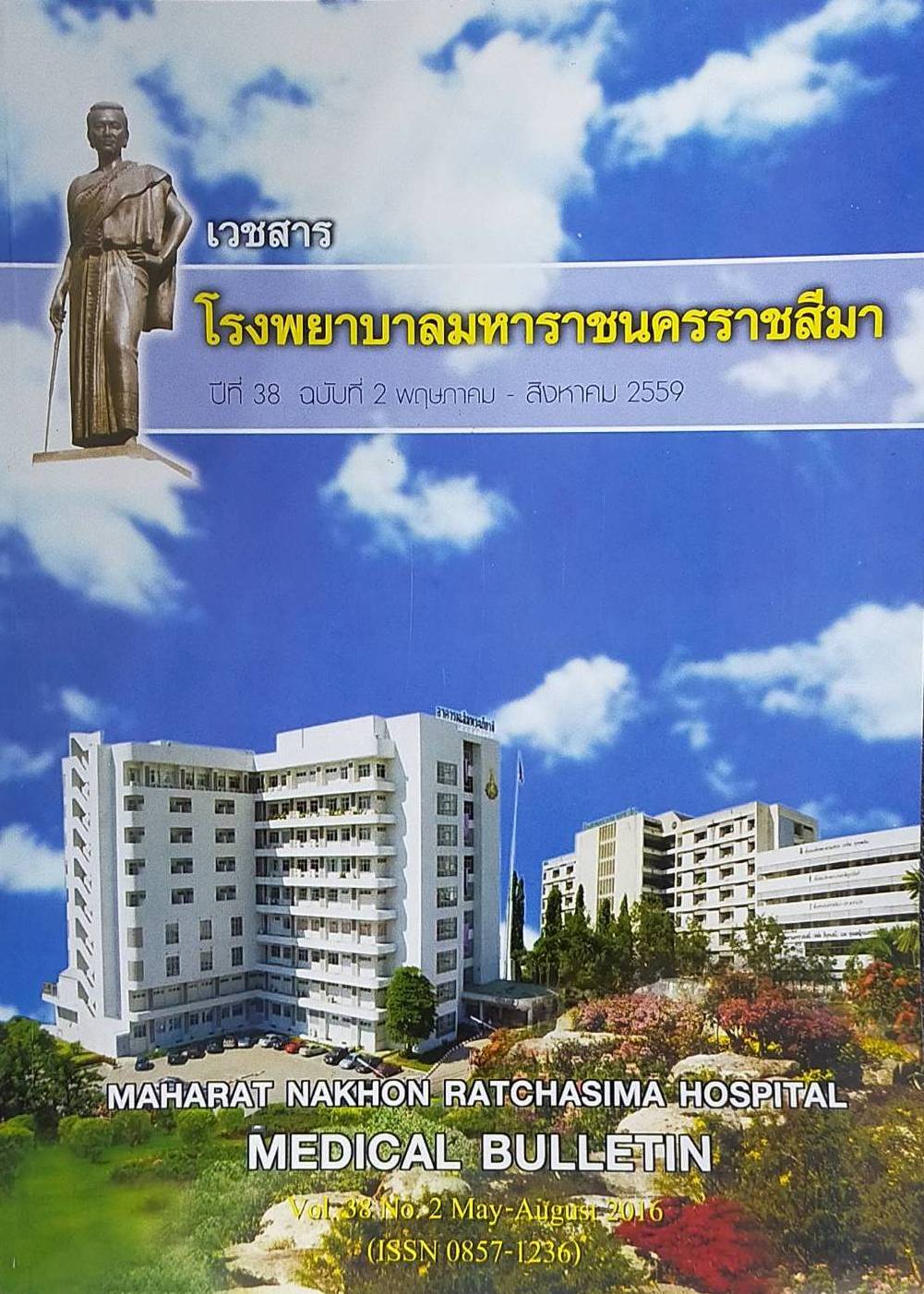Autoimmune Hemolytic Anemia ในชายสูงวัย: รายงานผู้ป่วย 1 ราย
Main Article Content
บทคัดย่อ
Autoimmune hemolytic anemia (AIHA) ถือว่าเป็นโรคเม็ดเลือดแดงแตกง่ายที่ยังพบได้น้อยโรคหนึ่ง อาจจะเกิดเป็นขึ้นมาเอง หรือเป็นจากสาเหตุต่าง ๆ รวมทั้งซิฟิลิสก็ได้ ในการศึกษานี้เป็นรายงานผู้ป่วยโรค AIHA ที่พบในชายสูงวัย ที่คิดว่าเกิดจากซิฟิลิสในระยะแฝงตัว ผู้ป่วยเป็นชายไทย อายุ 79 ปี มีอาการเหนื่อยง่าย แบบค่อยเป็นค่อยไปเป็นเวลา 3 สัปดาห์ โดยไม่มีไข้ ตรวจร่างกายพบเพียงซีดขนาดปานกลางอย่างเดียว ตรวจเลือดพบว่า direct antiglobulin test, VDRL รวมทั้ง FTA-Abs และ HBsAg ให้ผลบวก แต่ตรวจการทำงานของตับปกติ ตรวจ VDRL ในน้ำหล่อสมอง และไขสันหลังให้ผลลบ ให้การวินิจฉัยว่าเป็น AIHA ร่วมกับซิฟิลิสระยะแฝงตัว และเป็นพาหะของไวรัสตับอักเสบ บี หลังจากให้การรักษาด้วยการฉีด benzathine penicillin และ prednisolone 60 มก. ต่อวันจนครบ 3 สัปดาห์แล้ว ความเข้มข้น hemoglobin ก็ไม่เพิ่มจึงเพิ่มยา azathioprine และ danazol ภายในทั้งหมด 10 สัปดาห์ Hb เพิ่มขึ้นเล็กน้อยจาก 5.0 g% เป็น 7.0 g% โดยไม่ได้ให้การเติมเลือด โดยความเป็นจริงไม่ว่าจะเป็นโรคซิฟิลิส หรือการเป็นพาหะของไวรัสตับอักเสบ บี เป็นเวลานาน ๆ ก็ อาจจะ ส่งเสริมให้ ผู้ป่วยเกิด AIHA จนปรากฏอาการได้ ดังที่พบในผู้ป่วยรายนี้และทั้งสออย่างคงเป็นปัจจัยที่สำคัญทำให้ผู้ป่วย AIHA รายนี้ไม่ตอบสนองต่อยากดภูมิต้านทานต่าง ๆ ดังนั้นถ้าพบผู้ป่วย AIHA ที่ไม่มีสาเหตุชัดเจนในผู้ ชายสูงวัยการส่งตรวจเลือดเพื่อหาหลักฐานการติดเชื้อซิฟิลิส และไวรัสตับอักเสบ บี ไม่ควรจะถูกละเลย
Article Details

อนุญาตภายใต้เงื่อนไข Creative Commons Attribution-NonCommercial-NoDerivatives 4.0 International License.
เอกสารอ้างอิง
Rattarittamrong E, Eiamprapai P, Tantiworawit A, Rattanathammethee T, Hantrakool S, Chai- Adisaksopha C, et al. Clinical characteristics and long-term outcomes of warm-type autoimmune hemolytic anemia. Hematol 2016 Mar 21: 1-7
Sallah S, Wan JY, Hanrahan LR. Future development of lymphoproliferative disorders in patients with autoimmune hemolytic anemia. Clin Cancer Res 2001; 7: 791-4.
Urganci N, Akyildiz B, Yildirmak Y, Ozbay G. A case of autoimmune hepatitis and autoimmune hemolytic anemia following hepatitis A infection. Turk J Gastroenterol 2003; 14: 204-7.
Gehrs BC, Friedberg RC. Autoimmune hemolytic anemia. Am J Hematol 2002; 69: 258-71.
Garratty G. Drug-induced immune hemolytic anemia. ASH Education Book 2009; 2009: 73-9.
Olayemi E, Awodu OA, Bazuaye GN. Autoimmune hemolytic anemia in HIV-infected patients: a hospital based study. Ann Afr Med 2008; 7: 72-6.
Shizuma T. A case of autoimmune hemolytic anemia caused by type A influenza infection in a patient with alcoholic liver cirrhosis. Kansenshogaku Zasshi 2010; 84: 296-9. [Article in Japanese]
Kumar JK, Krishna Kumar HC, Manjunath VG, Arun V. Autoimmune hemolytic anemia due to varicella infection. Iran J Pediatr 2013; 23: 491-2.
Khan FY, Ayassin M. Mycoplasma pneumoniae associated with severe autoimmune hemolytic anemia: case report and literature review. Braz J Infect Dis 2009; 13: 77-9.
Thomas AT. Autoimmune hemolytic anemia. In: Lee GR, Foerster J, Lukens J, Paraskevas F, Greer JP, Rodgers GM, editors. Wintrobe’s Clinical Hematology, 10th edition, Baltimore: Williams & Wilkins, 1999.
Zanella A, Barcellini W. Treatment of autoimmune hemolytic anemias. Haematologica 2014; 94: 1547-54.
Morshed MG. Current trend on syphilis diagnosis: issues and challenges.AdvExp Med Biol 2014; 808: 51-64.
Yoshioka K, Miyata H. Autoimmune haemolyticanaemia in an asymptomatic carrier of hepatitis B virus. Arch Dis Child 1980; 55: 233-4.
Conley CL, Savarese DM. Biologic false-positive serologic tests for syphilis and other serologic abnormalities in autoimmune hemolytic anemia and thrombocytopenic purpura. Medicine 1989; 68: 67-84.
Ratnam S. The laboratory diagnosis of syphilis. Can J Infect Dis Med Microbiol 2005; 16: 45-51.
Khawaja S, Taj Y, Muqtadir KA. Warm autoimmune haemolyticanaemia and autoimmune hepatitis in an asymptomatic carrier of hepatitis B virus.J Pakistan Med Assoc 2011; 61: 512-5.

